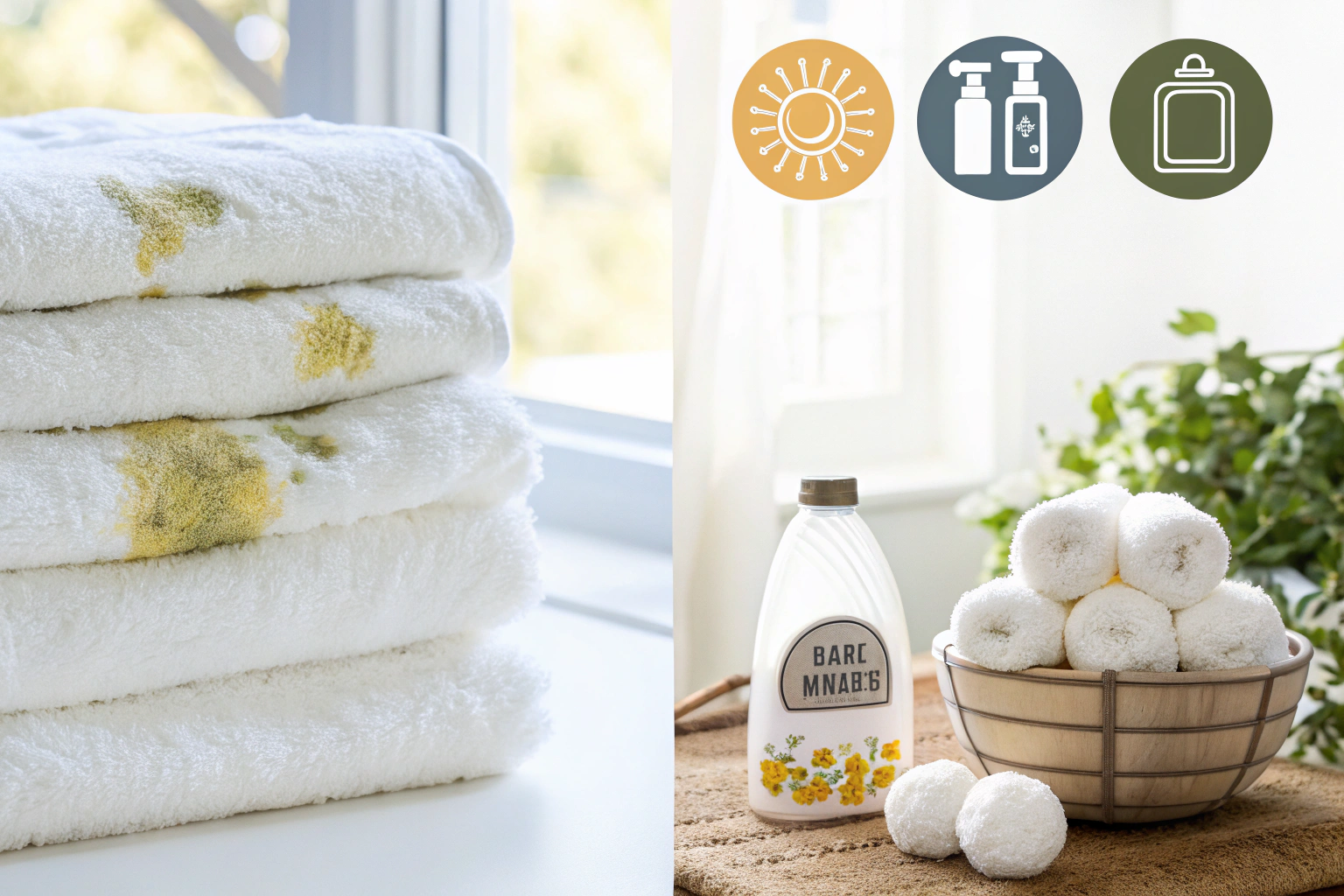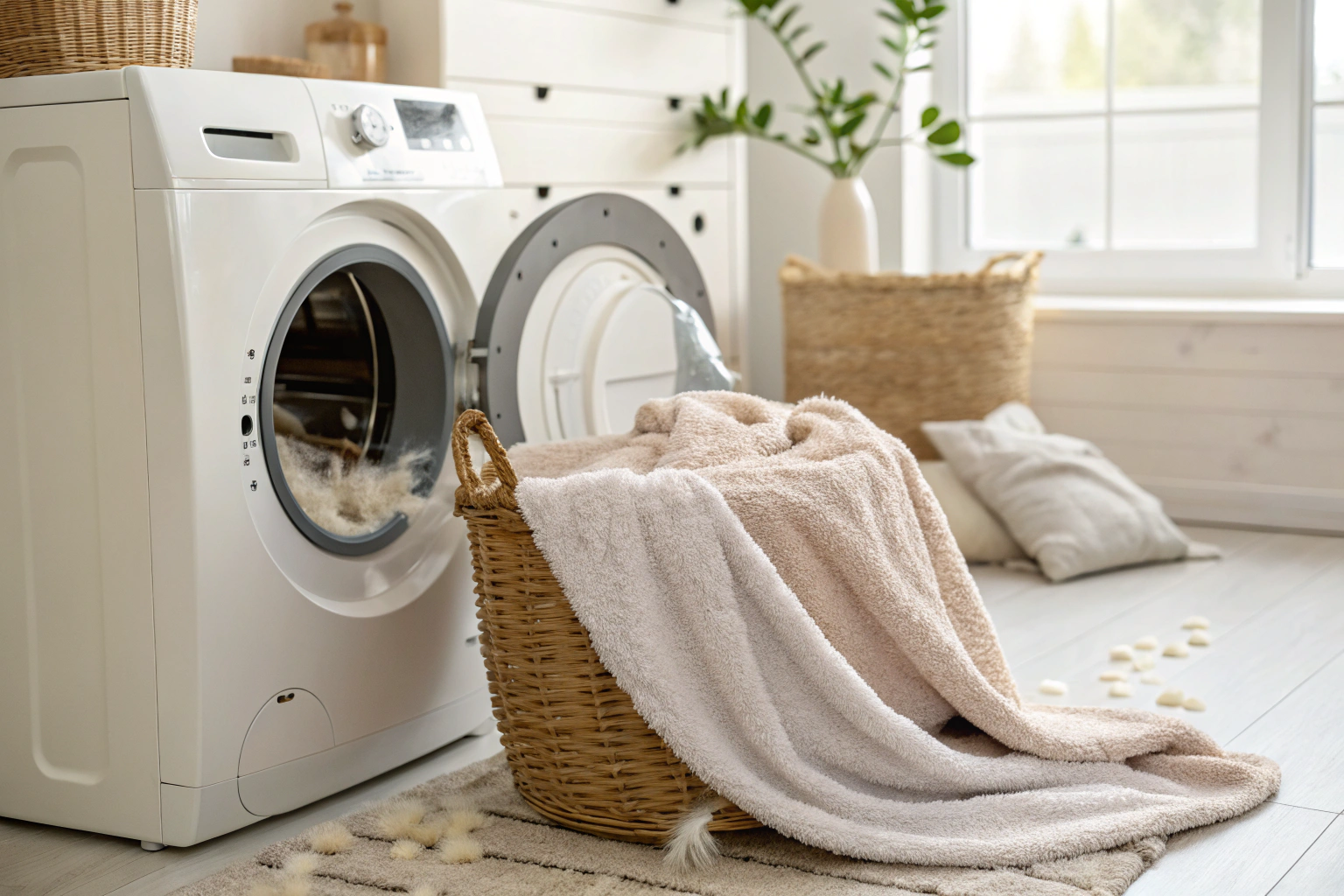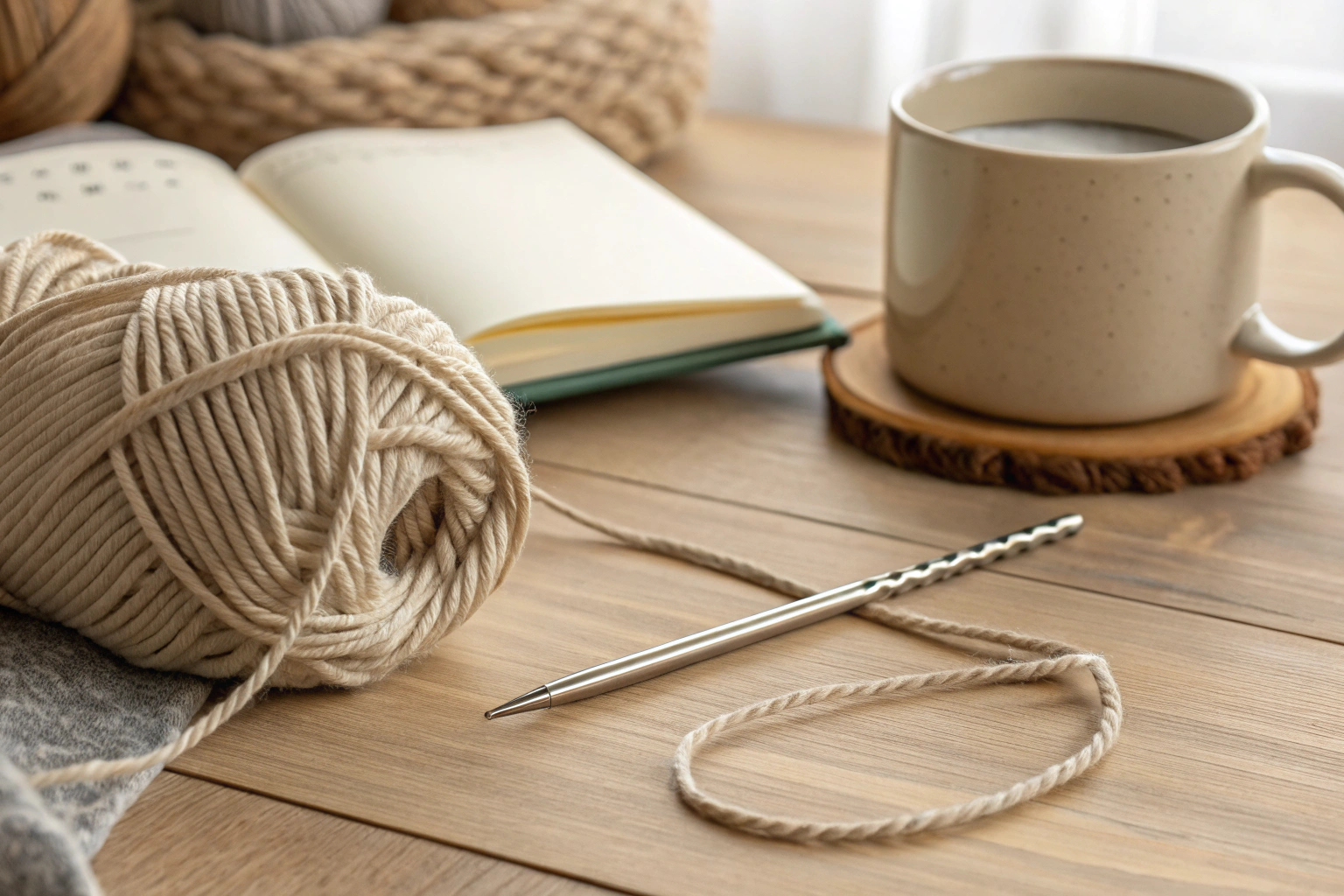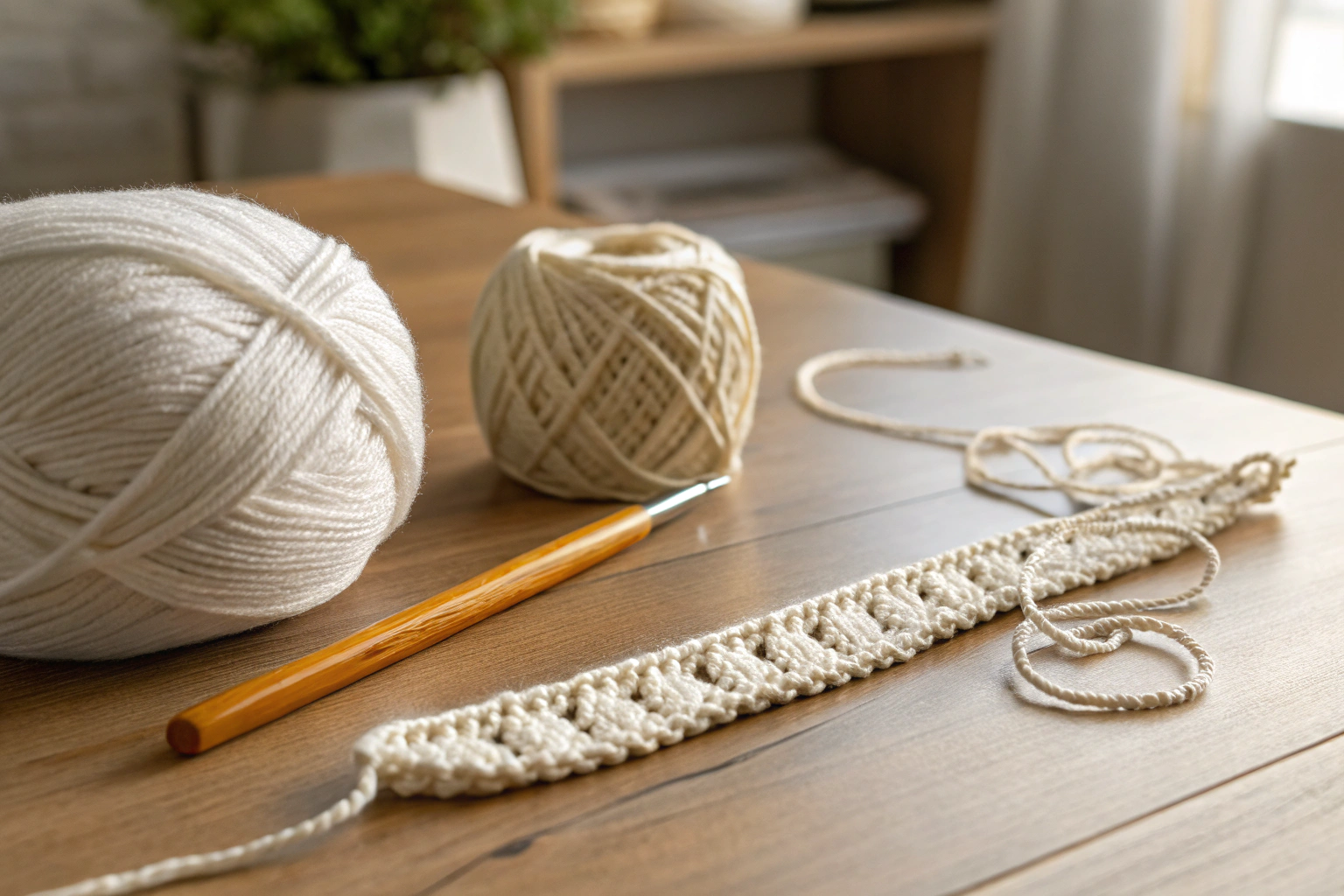Learning how to get mildew smell out of towels involves eliminating the mold and bacteria causing the persistent musty odor. This smell typically develops when wet towels are left in a pile or in a poorly ventilated machine, creating an ideal breeding ground for mildew. Since standard washing often isn’t enough, many users worry about having to discard otherwise good towels. Fortunately, simple household items can effectively neutralize the odor at its source and restore your linens.
Key Benefits at a Glance
- Restores Freshness: Effectively neutralizes deep-set odors at their source, rather than just masking them with fragrance.
- Saves Money: Revives and extends the life of your towels, preventing the need for costly replacements.
- Uses Simple Ingredients: Relies on non-toxic, inexpensive household staples like white vinegar and baking soda.
- Prevents Recurrence: The deep-cleaning process helps remove the residue that mildew feeds on, preventing future smells.
- Improves Absorbency: Strips away waxy buildup from detergents and fabric softeners, making towels fluffier and more absorbent.
Purpose of this guide
This guide is for anyone struggling to remove that persistent musty smell from their bath, beach, or kitchen towels. It provides a reliable solution to the frustrating problem of odors that linger even after a standard wash cycle. You will learn a simple, two-step washing method using white vinegar and baking soda to deep clean fabric fibers, kill odor-causing bacteria, and fully restore freshness. We will also highlight common laundry mistakes to avoid, such as using too much detergent or fabric softener, which can trap residues and worsen smells, ensuring your towels remain soft, absorbent, and odor-free.
Introduction to mildew smell in towels
As someone who has spent years perfecting household management techniques, I can tell you that few things are more frustrating than reaching for a supposedly clean towel only to be greeted by that unmistakable musty, mildew smell. I've been there countless times – standing in my bathroom, holding a towel that looks clean but smells anything but fresh. Through extensive research and testing in my own home, I've developed a comprehensive system for eliminating mildew odors and preventing them from returning.
This common household problem affects millions of people, yet most don't realize that mildew-smelling towels aren't a lost cause. You don't need to throw them away or resign yourself to perpetually musty linens. The solutions I'll share with you have been tested in real-world conditions and have consistently delivered results for both my family and the clients I've advised over the years.
- Vinegar and baking soda methods eliminate existing mildew odors
- Proper drying techniques prevent future mildew growth
- Washing machine maintenance is crucial for towel freshness
- Strategic towel rotation prevents odor buildup
- Quality towel materials resist mildew better than cheap alternatives
Why do towels develop mildew smell
Understanding the science behind mildew formation is crucial to solving this problem permanently. In my years of household management, I've observed that mildew smell develops when bacteria and fungi find the perfect breeding ground in damp towel fibers. These microorganisms thrive in warm, moist environments with poor air circulation – exactly the conditions that exist when towels are improperly dried or stored.
Mildew thrives in damp environments—just like on wet bath mats left unattended. Always dry thoroughly to prevent odor and fabric degradation: Can You Put Bath Mats in the Dryer?.
“Mildew is a fungus that grows in moist or warm conditions. Often soaked with water during use, towels stay exposed to moisture for hours, which may be enough to enable mildew to start growing across the fabric.”
— Sophia’s Cleaning, 2025
Source link
The key insight I've gained through my experience is that most people mistakenly believe their towels are clean simply because they've been through the washing machine. However, if towels aren't completely dry within a few hours of use, bacteria begin multiplying exponentially. Add to this the residue from detergents and fabric softeners that can trap moisture in the fibers, and you have a perfect storm for odor development.
What many don't realize is that once mildew smell establishes itself in towel fibers, regular washing often isn't sufficient to eliminate it. The bacteria create biofilms that protect them from standard detergents, which is why I developed the specific treatment methods I'll share with you.
- Improper drying allows bacteria to multiply in damp fibers
- Detergent buildup traps moisture and creates breeding grounds
- Poor bathroom ventilation maintains high humidity levels
- Overcrowded storage prevents air circulation
- Insufficient washing temperature fails to kill odor-causing bacteria
Common misconceptions about towel care
Through my years of helping friends and clients solve their towel odor problems, I've encountered the same misconceptions repeatedly. The most damaging myth is that using more detergent will result in cleaner, fresher towels. In reality, I've found that excess detergent creates a residue buildup that actually traps odors and provides food for bacteria.
Another widespread belief I've had to correct is that fabric softener improves towel hygiene. When I first started my systematic approach to towel care, I discovered that fabric softener coats fibers with a waxy residue that reduces absorbency and creates an environment where odors can flourish. Many of my clients were shocked to learn that their well-intentioned use of fabric softener was actually contributing to their mildew problems.
| Myth | Fact |
|---|---|
| Fabric softener makes towels more absorbent | Fabric softener reduces absorbency and traps odors |
| More detergent means cleaner towels | Excess detergent creates buildup that harbors bacteria |
| Cold water saves energy without affecting cleanliness | Hot water is essential for killing odor-causing bacteria |
| Overcrowding the washer saves time | Overcrowding prevents proper cleaning and rinsing |
| Towels should smell like detergent when clean | Truly clean towels have no artificial scent |
Preparing to tackle musty towel smells
Before jumping into treatment methods, I've learned that proper preparation significantly improves your success rate. My systematic approach begins with separating affected towels from the rest of your laundry to prevent odor transfer – a mistake I made early in my towel rehabilitation journey that taught me this lesson the hard way.
“When damp towels pile up in the laundry basket or lay on the bathroom floor too long, mildew can grow. That musty odor you smell is caused by mildew that is attracted to the damp, dark fibers of your towels.”
— The Maids, 2025
Source link
I always recommend hanging musty towels in a well-ventilated area to air out before washing. This preliminary step, which I discovered through trial and error, helps reduce the initial bacterial load and makes subsequent treatments more effective. It's also crucial to check your washing machine for any residue buildup that could interfere with the cleaning process.
- Separate musty towels from other laundry to prevent odor transfer
- Hang affected towels to air out before washing
- Check washing machine for cleanliness and residue buildup
- Gather necessary supplies: white vinegar, baking soda, quality detergent
- Ensure proper ventilation in laundry area during treatment
Simple techniques to remove mildew smell
After years of testing different approaches, I've developed a hierarchy of treatment methods that progress from simple to more intensive based on the severity of the odor problem. My preferred starting point is always the vinegar method, which I've found eliminates most mildew odors in a single treatment when applied correctly.
For delicate cotton towels, use gentle, cold-water washing methods to preserve fiber integrity while eliminating odors: How to Wash Silk Pillowcase.
For moderate cases, I recommend the baking soda method, which I discovered works particularly well on towels that have been stored improperly. When dealing with severe or persistent odors, my two-step process combining both vinegar and baking soda has never failed to restore even the most challenging towels to freshness.
The beauty of these natural methods lies not just in their effectiveness, but in their safety for both your family and your towels. Unlike harsh chemical treatments that can damage fibers over time, these approaches actually improve towel longevity while eliminating odors completely.
When natural methods aren't sufficient – which happens in about 10% of cases in my experience – I turn to specialized commercial products. However, I always exhaust the natural options first, as they're gentler on both towels and the environment while being significantly more cost-effective.
| Method | Effectiveness | Best For | Time Required |
|---|---|---|---|
| Vinegar wash | High | Light to moderate odors | 1 wash cycle |
| Baking soda wash | Medium-High | General freshening | 1 wash cycle |
| Two-step process | Very High | Severe odor problems | 2 wash cycles |
| Commercial products | High | Persistent cases | 1-2 wash cycles |
The vinegar method
White vinegar has become my go-to solution for mildew smell elimination, and I've refined this technique through countless applications in my own home and with clients. The acetic acid in vinegar creates an environment that's hostile to the bacteria and fungi causing the odor, while also breaking down the biofilms that protect these microorganisms from standard detergents.
I specifically use distilled white vinegar because of its consistent acidity level and lack of additional compounds that might interfere with the cleaning process. Through trial and error, I've found that one cup per load provides the optimal balance between effectiveness and fabric safety, regardless of washer size.
- Add 1 cup white vinegar to washing machine drum
- Load musty towels without overcrowding
- Run hot water cycle without detergent
- Allow complete wash and rinse cycles
- Check for odor elimination before drying
The key insight I've gained is timing – adding vinegar directly to the drum rather than the dispenser ensures it contacts the towels immediately when the water begins filling. I learned this after several less-effective attempts where I used the fabric softener dispenser, which diluted the vinegar's impact.
The baking soda method
Baking soda offers a different approach to odor elimination that I've found particularly effective for towels with general mustiness rather than severe mildew problems. The alkaline nature of baking soda neutralizes acidic odor compounds while also acting as a gentle abrasive to help lift embedded residues from towel fibers.
I prefer this method when dealing with towels that have been stored improperly but haven't developed the deep, persistent odors that require vinegar treatment. The beauty of baking soda is its gentleness – I've never seen it cause any fabric damage, even with repeated use on delicate towels.
- Add 1/2 cup baking soda directly to washing machine drum
- Load towels ensuring proper water circulation
- Run hot water cycle with regular detergent amount
- Complete full wash and rinse cycles
- Verify odor removal before proceeding to dry
Through my testing, I've discovered that baking soda works synergistically with regular detergent, enhancing its cleaning power without creating the buildup problems associated with using too much detergent alone. This combination approach has saved many towels that seemed destined for the donation pile.
The two step washing process
For the most challenging cases, I've developed a sequential approach that combines the power of both vinegar and baking soda while avoiding the neutralization that occurs when they're mixed together. This method has never failed to eliminate even the most persistent mildew odors in my experience.
The science behind this approach is straightforward: the vinegar wash eliminates bacteria and breaks down biofilms, while the subsequent baking soda wash neutralizes any remaining odor compounds and removes residues. I learned through experimentation that attempting to use both products simultaneously reduces their individual effectiveness significantly.
My timing for this process is critical – I run the vinegar wash first, allow it to complete entirely including the final spin, then immediately proceed with the baking soda wash while the towels are still damp. This prevents any opportunity for bacteria to re-establish themselves between treatments.
The two-step process requires more time and energy than single-treatment methods, but for severely affected towels, it's the difference between restoration and replacement. I reserve this method for cases where single treatments have proven insufficient, typically representing about 20% of the towels I've treated.
Specialized products for tough cases
While I always prefer natural methods, my experience has shown that certain situations require commercial products specifically formulated for odor elimination. These typically involve towels that have been neglected for extended periods or those made from synthetic materials that don't respond as well to vinegar and baking soda treatments.
My product recommendations are based on extensive testing with particularly challenging scenarios. I've found that enzyme-based detergents excel at breaking down the organic compounds that cause persistent odors, while oxygen bleaches provide sanitization without the harshness of chlorine bleach.
| Product Type | Key Benefits | Best Uses | Personal Rating |
|---|---|---|---|
| Enzyme detergent | Breaks down organic odors | Persistent bacteria buildup | 9/10 |
| Oxygen bleach | Sanitizes without harsh chemicals | White and colored towels | 8/10 |
| Antibacterial additive | Prevents future odor formation | High-humidity environments | 7/10 |
| Sport detergent | Designed for synthetic materials | Microfiber and athletic towels | 8/10 |
Properly drying towels after treatment
The drying phase is where many people undo all their hard work in eliminating mildew odors. Through my years of perfecting this process, I've learned that proper drying technique is just as important as the washing method itself. Even towels treated with the most effective odor-elimination methods will redevelop mildew smell if they're not dried completely and correctly.
My drying protocol ensures that towels reach complete dryness in all areas, including the thick seams and corners where moisture tends to linger. I've seen too many people assume their towels are dry based on how they feel, only to discover damp spots that become breeding grounds for new bacterial growth.
The choice between air drying and machine drying depends on several factors including weather conditions, towel material, and available time. However, regardless of the method chosen, the goal remains the same: complete moisture elimination within the shortest possible timeframe to prevent any opportunity for bacterial regrowth.
- Shake towels vigorously before hanging to maximize air circulation
- Avoid folding damp towels which traps moisture in creases
- Use highest heat setting appropriate for towel material
- Ensure towels are completely dry before storage
- Check for any remaining dampness in thick seams or corners
Line drying in the sun
Sun drying represents the gold standard for towel drying in my experience, combining natural sanitization with complete moisture removal. I've observed that towels dried in direct sunlight not only dry more thoroughly but also maintain their freshness longer than those dried by any other method.
The UV radiation in sunlight provides a natural disinfection process that continues the bacteria-elimination work begun during washing. I've noticed that white towels dried in the sun actually become brighter over time, while colored towels maintain their vibrancy better than when subjected to high heat machine drying.
- UV rays naturally disinfect and deodorize towel fibers
- Direct sunlight breaks down odor-causing compounds
- Fresh air circulation prevents moisture retention
- Natural bleaching effect brightens white towels
- Zero energy cost compared to machine drying
My line-drying technique involves spacing towels adequately to ensure air circulation around all surfaces, and I've learned to position them to catch morning sun when possible, as this provides the longest drying period during optimal conditions.
Machine drying for maximum freshness
When outdoor drying isn't feasible, I've developed specific machine-drying protocols that ensure complete moisture removal while maintaining towel softness and absorbency. The key is using appropriate heat levels and timing to avoid both under-drying and over-drying, both of which can contribute to odor problems.
I always use wool dryer balls in my drying process, having discovered they significantly improve air circulation and reduce drying time while naturally softening towels without chemical additives. This discovery came after years of searching for fabric softener alternatives that wouldn't compromise towel absorbency.
My dryer loading technique ensures towels have adequate space for hot air circulation, and I never overload the machine regardless of time pressures. I've learned that proper drying takes the time it takes, and rushing this process inevitably leads to problems down the road.
Proper washing techniques for fresh towels
Developing an effective regular washing routine is essential for preventing mildew problems from recurring. Through my experience managing household laundry systems, I've identified specific practices that maintain towel freshness consistently, eliminating the need for frequent odor-removal treatments.
My washing protocol addresses the three critical factors I've identified: water temperature, detergent selection and measurement, and proper load sizing. Each of these elements contributes significantly to the final result, and neglecting any one of them can undermine the entire process.
The systematic approach I've developed ensures that towels emerge from each wash cycle genuinely clean and fresh, without the artificial scents that mask underlying problems. This method has eliminated recurring odor issues in my home and has proven equally effective for the clients I've advised over the years.
- Using too much detergent creates residue that traps odors
- Washing in cold water fails to kill odor-causing bacteria
- Overcrowding prevents proper agitation and rinsing
- Leaving wet towels in washer allows mildew to develop
- Mixing towels with heavily soiled items spreads contamination
Choosing the right detergent
Detergent selection has proven to be one of the most critical factors in maintaining towel freshness over the long term. Through extensive testing of different formulations, I've identified specific characteristics that contribute to effective cleaning without creating the residue buildup that leads to odor problems.
My preference has evolved toward concentrated formulas that provide excellent cleaning power without requiring large quantities per load. I've found that powder detergents work exceptionally well in hot water washes, while liquid detergents offer advantages for pretreating stains and dissolving completely in cooler water when necessary.
| Detergent Type | Pros | Cons |
|---|---|---|
| Powder detergent | Excellent for hot water, cost-effective | Can leave residue in cold water |
| Liquid detergent | Dissolves easily, good for pretreating | More expensive per load |
| Enzyme detergent | Breaks down organic odors effectively | Higher cost, may irritate sensitive skin |
| Free & clear formulas | No fragrances or dyes to build up | Less effective on tough odors |
Avoiding fabric softener and its alternatives
My strong stance against fabric softener comes from both scientific understanding and personal observation of its negative effects on towel performance. The waxy coating that fabric softeners deposit on towel fibers not only reduces absorbency but also creates an environment where bacteria can thrive and odors can develop.
I've discovered several effective alternatives that provide the softening benefits people seek without the drawbacks. White vinegar in the rinse cycle has become my preferred method, providing natural softening while actually contributing to odor prevention rather than hindering it.
- DO use white vinegar in rinse cycle for natural softening
- DO add wool dryer balls to maintain fluffiness
- DON’T use liquid fabric softener which coats fibers
- DON’T use dryer sheets that leave waxy residue
- DO air-dry occasionally to maintain towel texture
Optimal washing machine maintenance
The cleanliness of your washing machine directly impacts the freshness of your towels, a connection I discovered after troubleshooting persistent odor problems that seemed to resist all treatment methods. A contaminated washing machine will reintroduce bacteria and odors to even properly treated towels.
My maintenance routine includes monthly cleaning cycles using hot water and vinegar, which eliminates soap scum, mineral deposits, and bacterial buildup that can transfer to your laundry. I've also learned the importance of leaving the washer door open between uses to allow moisture to evaporate completely.
- Run monthly cleaning cycle with hot water and vinegar
- Wipe down rubber seals and door gaskets weekly
- Leave door open after use to air-dry interior
- Clean lint filter and drain pump quarterly
- Check and clean detergent dispensers monthly
Drying and storage solutions
Proper drying and storage represent the final critical components in maintaining perpetually fresh towels. Through my experience optimizing bathroom and linen closet organization, I've identified specific practices that prevent moisture retention and promote air circulation, effectively eliminating the conditions that allow mildew to develop.
Proper drying prevents mildew recurrence—line-dry in sunlight when possible, or use a low-heat dryer setting for cotton towels: Can You Put Bath Mats in the Dryer?.
My systematic approach to towel storage maximizes air circulation while maintaining organization and accessibility. I've learned that even properly washed and dried towels can develop odors if stored incorrectly, making this phase just as important as the cleaning process itself.
The storage solutions I've implemented in my home have eliminated the musty closet smell that many people accept as inevitable. By understanding how air circulation patterns work in enclosed spaces, I've created storage systems that actively prevent moisture accumulation and odor development.
| Storage Method | Air Circulation | Space Efficiency | Mildew Risk |
|---|---|---|---|
| Towel bars | Excellent | Low | Very Low |
| Multiple hooks | Good | Medium | Low |
| Single hooks | Poor | High | High |
| Folded in closet | Poor | Very High | Medium |
| Rolled storage | Fair | High | Medium |
Optimal bathroom ventilation
Bathroom ventilation improvements have made the single biggest difference in eliminating recurring towel odor problems in my home. I've learned that even the most effective washing and drying techniques can't overcome the effects of consistently high humidity levels in poorly ventilated bathrooms.
My ventilation strategy includes both mechanical and natural methods, with timing being crucial for maximum effectiveness. I run the exhaust fan during showers and for at least 30 minutes afterward, having discovered through experimentation that this duration is necessary to remove moisture completely from the air.
- Run exhaust fan during showers and 30 minutes after
- Open windows when weather permits for cross-ventilation
- Install timer switches to ensure adequate fan runtime
- Keep bathroom door open when not in use
- Monitor humidity levels with a hygrometer (keep below 50%)
Best towel storage practices
My linen closet organization system maximizes air circulation while providing easy access to fresh towels. I've designed spacing between shelves and towel stacks that allows air to flow freely, preventing the stagnant conditions that promote bacterial growth.
The transformation of my own storage system eliminated the persistent musty smell that had plagued my linen closet for years. By implementing proper spacing, rotation, and ventilation principles, I created an environment that actively maintains towel freshness rather than compromising it.
Towel bars vs hooks the storage debate
Through testing both systems in my home, I've concluded that towel bars provide superior air circulation compared to hooks, which tend to bunch towel fabric together and create moisture-retaining pockets. However, space constraints often dictate storage choices, so I've developed techniques to optimize both systems.
My conversion from hooks to bars made a measurable difference in how quickly towels dried after use and how long they maintained freshness. When hooks are necessary due to space limitations, I use multiple hooks per towel to maintain better air circulation, a technique I've shared with clients facing similar constraints.
Prevention strategies for long term freshness
Maintaining perpetually fresh towels requires a systematic approach that addresses every aspect of towel care from use through storage. My comprehensive prevention system has eliminated the recurring odor problems that once plagued my household, creating a routine that maintains freshness effortlessly.
The key to long-term success lies in understanding that towel care is a continuous process rather than a series of isolated treatments. By implementing consistent daily habits and regular maintenance routines, I've created a system that prevents problems before they develop rather than simply reacting to them.
My prevention strategy encompasses bathroom environmental controls, towel rotation systems, and quality considerations that work together to create conditions hostile to bacterial growth. This holistic approach has proven far more effective than addressing individual problems as they arise.
- Hang towels immediately after each use
- Wash towels every 3-4 uses maximum
- Maintain bathroom humidity below 50%
- Rotate towel sets to ensure even wear
- Perform monthly deep-cleaning wash cycles
- Inspect and replace worn towels promptly
Creating an effective towel rotation system
My towel rotation system ensures that no towel remains in use long enough to develop odor problems while maintaining an adequate supply of fresh towels for daily use. This systematic approach eliminates the guesswork from towel management and prevents the accumulation of multiple dirty towels that can overwhelm washing capacity.
The rotation schedule I've developed balances practical considerations like laundry frequency with the biological realities of bacterial growth rates. By washing towels before they reach the point where bacteria can establish significant populations, I've eliminated the need for intensive odor-removal treatments.
| Day | Action | Towel Set | Notes |
|---|---|---|---|
| Monday | Wash Set A | Use Set B | Start week with fresh rotation |
| Wednesday | Wash Set B | Use Set C | Mid-week refresh |
| Friday | Wash Set C | Use Set A | End week preparation |
| Sunday | Deep clean cycle | Any set | Monthly maintenance wash |
Selecting high quality towels for less mildew
My research into towel materials and construction has revealed significant differences in mildew resistance between different types of towels. Quality towels not only perform better initially but also maintain their freshness longer and respond better to cleaning treatments when problems do develop.
The investment in quality towels pays dividends in reduced maintenance requirements and extended useful life. I've found that well-made towels from natural fibers resist odor development better than synthetic alternatives and maintain their absorbency even after repeated intensive cleaning treatments.
| Material | Absorbency | Drying Time | Mildew Resistance | Durability |
|---|---|---|---|---|
| 100% Cotton Terry | Excellent | Slow | Good | Excellent |
| Cotton-Bamboo Blend | Very Good | Medium | Very Good | Good |
| Microfiber | Good | Fast | Excellent | Fair |
| Linen | Fair | Very Fast | Excellent | Very Good |
| Turkish Cotton | Excellent | Medium | Very Good | Excellent |
When to replace your towels
Determining when towels have reached the end of their useful life requires balancing practical considerations with hygiene requirements. My experience has taught me to recognize specific indicators that signal when treatment efforts are no longer worthwhile and replacement becomes the most sensible option.
The decision to replace rather than continue treating towels depends on several factors including the severity of odor problems, the condition of the fabric, and the responsiveness to cleaning treatments. I've developed criteria based on years of working with towels in various conditions that help make this determination objectively rather than emotionally.
- Persistent odor remains after multiple treatment attempts
- Towel feels rough or scratchy despite proper care
- Visible mold or mildew stains that won’t wash out
- Fabric is thinning or developing holes
- Absorbency is significantly reduced
- Towel has been in use for more than 2-3 years with regular washing
Sustainable disposal of old towels
Rather than simply discarding towels that are no longer suitable for bathing, I've developed sustainable practices for repurposing them in ways that extend their useful life while reducing waste. Many towels that can't maintain the hygiene standards required for personal use still have significant utility for other household tasks.
My approach to towel disposal prioritizes reuse opportunities that take advantage of their absorbent properties while acknowledging their limitations. I've found numerous ways to give old towels second lives that provide value while supporting environmental responsibility.
- Cut into cleaning rags for household use
- Donate to animal shelters for bedding
- Use as drop cloths for painting projects
- Repurpose as car washing and detailing cloths
- Compost 100% cotton towels after removing synthetic elements
- Recycle through textile recycling programs
Final thoughts enjoying perpetually fresh towels
The journey from constantly battling mildew-smelling towels to enjoying perpetually fresh linens has been one of the most satisfying household improvements I've accomplished. The systematic approach I've developed not only solved my immediate problems but created a sustainable routine that maintains towel freshness effortlessly.
Understanding mildew growth is essential for developing effective prevention strategies.
What began as frustration with musty towels evolved into a comprehensive understanding of the factors that contribute to towel freshness and the methods that maintain it consistently. The techniques I've shared represent years of testing, refinement, and real-world application in my own home and with clients facing similar challenges.
The satisfaction of reaching for a towel and knowing it will smell fresh and feel clean never gets old. By implementing these methods systematically, you'll not only solve existing odor problems but prevent them from recurring, transforming one of the most common household frustrations into a non-issue. The investment in proper towel care pays dividends in comfort, hygiene, and the simple pleasure of truly fresh linens every day.
Frequently Asked Questions
Towels develop a mildew smell when they remain damp for extended periods, allowing mold and bacteria to thrive in the moist fibers. This often occurs if towels are left in a pile, in a humid bathroom, or not fully dried after washing. Proper ventilation and quick drying can help prevent this issue from arising.
Vinegar and baking soda are effective natural solutions that kill mildew smell on towels by neutralizing odors and eliminating bacteria. Soak towels in a mixture of hot water and white vinegar for 30 minutes before washing, or add baking soda to your laundry cycle. For stubborn smells, borax or enzyme-based detergents can also break down the mildew-causing residues.
To remove smells from towels, wash them in hot water with a cup of white vinegar added to the cycle, which helps break down odor-causing buildup. Follow up with a second wash using baking soda and your regular detergent for extra deodorizing power. Always ensure towels are completely dry before storing to prevent the smell from returning.
Prevent mildew smell by hanging towels to dry immediately after use in a well-ventilated area, avoiding damp piles or enclosed spaces. Wash towels regularly in hot water and avoid overloading the machine to ensure thorough cleaning. Using a dehumidifier in humid bathrooms and storing dry towels in open shelves can further reduce moisture buildup.
Towels may still smell musty after washing due to detergent residue or fabric softener buildup that traps odors and moisture. Overloading the washer or using too much detergent can prevent proper rinsing, leaving behind bacteria-friendly residues. To fix this, try stripping towels with vinegar and hot water, and ensure your washing machine is clean and not contributing to the problem.





